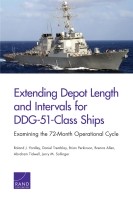| 来源类型 | Research Reports
|
| 规范类型 | 报告
|
| DOI | https://doi.org/10.7249/RR1235
|
| ISBN | 9780833094155
|
| 来源ID | RR-1235-NAVY
|
| Extending Depot Length and Intervals for DDG-51-Class Ships: Examining the 72-Month Operational Cycle |
| Roland J. Yardley; Daniel Tremblay; Brian Perkinson; Brenna Allen; Abraham Tidwell; Jerry M. Sollinger
|
| 发表日期 | 2016
|
| 出版年 | 2016
|
| 页码 | 122
|
| 语种 | 英语
|
| 结论 |
Benefits, Costs, and Challenges Associated with a 72-Month Operational Cycle- Moving to a 72-month operational cycle would increase operational presence by about 7 percent, relative to a 32-month cycle.
- A 72-month operational cycle could lead to greater cohesion among crew members, because they would stay together longer and deploy together more often.
- Moving to a 72-month operational cycle would reduce the number of crews needed for the fleet. This could lead to manpower savings, but only if the Navy were to divest itself of these surplus crews and reduce end strength.
- A 72-month operational cycle would lead to a substantial increase in maintenance costs, relative to the 32-month cycle. In the long term, this increase would more than offset the potential savings from reduced end strength.
- It is unclear whether a 72-month cycle will help the Navy cope with several maintenance issues that have accrued over the years.
|
| 摘要 |
- Before moving to a longer interval between depot maintenance, improve current maintenance planning and execution. The Navy should correct impediments to availability execution, fully document maintenance requirements for surface combatants, develop a maintenance plan for the longer cycle that increases continuous maintenance and focuses on lifecycle critical maintenance, and evaluate the effect of maintenance demands on private providers.
- Ships entering a longer operational cycle should do so in a high state of material readiness, and this should be verified this with complete evaluations of readiness.
- Award maintenance availabilities in a fashion that allows for sufficient time for planning the work; the surface type commander must commit funding at the time of the award.
- Fine-tune training to fit additional deployment needs.
- Closely manage operating tempo.
- Use the model described in this report to provide a fleet-wide examination of maintenance and operational deployments, and how best to manage the various factors that are affected.
|
| 主题 | Maintenance
; Repair
; and Overhaul
; Military Budgets and Defense Spending
; Military Force Planning
; Military Ships and Naval Vessels
; United States Navy
|
| URL | https://www.rand.org/pubs/research_reports/RR1235.html
|
| 来源智库 | RAND Corporation (United States)
|
| 引用统计 |
|
| 资源类型 | 智库出版物
|
| 条目标识符 | http://119.78.100.153/handle/2XGU8XDN/108213
|
推荐引用方式
GB/T 7714 |
Roland J. Yardley,Daniel Tremblay,Brian Perkinson,et al. Extending Depot Length and Intervals for DDG-51-Class Ships: Examining the 72-Month Operational Cycle. 2016.
|
|
文件名:
|
x1495316192254.jpg
|
|
格式:
|
JPEG
|

|
文件名:
|
RAND_RR1235.pdf
|
|
格式:
|
Adobe PDF
|
除非特别说明,本系统中所有内容都受版权保护,并保留所有权利。